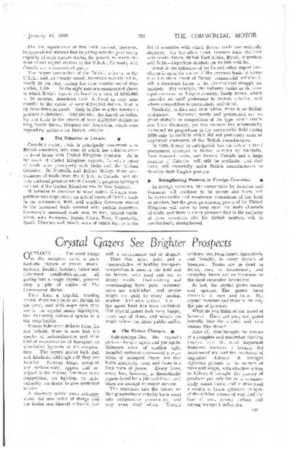Crystal Qazers See Brighter Prospects
Page 69

If you've noticed an error in this article please click here to report it so we can fix it.
OUTLOOK. . . , The word brings to the receptive mind a partfantastic picture of trader, manufacturer, haulier, butcher, baker and C-licensed candlestick-maker, all gazing into a magic Crystal, perched atop a pile of copies of The Commercial Motor.
They form a hopeful, trusting crowd, these men (who are British to the core), and with eager eyes they see in the crystal many highlights, like brilliantly coloured specks in a big soap-bubble.
Visions take more definite form. Lo and behold, there is seen first the spectre of nationalization and then that of co-ordination of transport, as alternative figments of the imagina tion. The crystal-gazers look dull and fatalistic, although still they are hopeful. Railway, kings, arrogant and well-satisfied, appear and reappear in the visiOns, but there is no competition, no fighting, no individuality nor desire to give unstinted service.
A visionary public looks unhappy about the new order of things and our trader sees himself reflected, but with a countenance full of despair.
Then that scene fades and a representation of healthy transportcompetition is seen--a fair field and no favour, with road and rail as decent rivals. Undercutting and overcharging have gone, economic rates are established, and proper wages are paid to every haulage worker. Ah I what is this? Yes. . . the speed limit has been abolished. Our crystal-gazers look very happy, every one of them, and within the magic sphere the ghost public smiles.
• The Picture Changes. • Kaleidoscope-like, the crystal's picture changes again and yet again. Glimpses come of another ugly, dreadful national crisis—and a repetition of transport chaos; but that fades mercifully away and there is a long vista of peace. Every lorry, every bus, however, is theoretically pigeon-holed for a job in defence, and there are enough to ensure success.
The searchers into the future see that gas-producer vehicles have come into comparative prominence, and may even rival oilers. Electric vehicles, too, loom larger, figuratively and literally, in every branch of transport. Trams are as dead as dodos, rocs, or brontosaur:, and everyday buses are as luxurious as the most expensive limousines.
At last, the crystal grows smoky and opaque. The gazers leave dreamily in ones and twos. The crystal vanishes and there is left only the, pile of journals.
What do you think of our mood of fantasy? Have not you, too, gazed intently into the crystal and seen visions like those?
After all, 1938 brought the genesis of a complete and somewhat startling inquiry into the most important transport matters; it brought the nearness of war and the revelation of imperfect defence; it brought righteous protests in the matters of rates and wages, with effective action to follow; it brought the placing of producer-gas vehicles on a commercially sound basis; and it developed a wealth of brave optimism in spite of the red-hot arrows of war, and the fear of war, among nations and among transport industries.




















































































































































